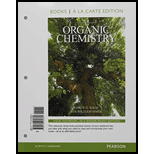
(a)
To determine: The formation of given ether in good yield by condensation of the corresponding alcohol and the alternative method for the ether that cannot be prepared by the condensation of the alcohols.
Interpretation: The formation of given ether in good yield by condensation of the corresponding alcohol and the alternative method for the ether that cannot be prepared by the condensation of the alcohols is to be identified.
Concept introduction: In a condensation reaction, two molecules join together to form a large molecule with the removal of small molecule such as water.
(b)
To determine: The formation of the given ether in good yield by condensation of the corresponding alcohol and the alternative method for the ether that cannot be prepared by the condensation of the alcohols.
Interpretation: The formation of given ether in good yield by condensation of the corresponding alcohol and the alternative method for the ether that cannot be prepared by the condensation of the alcohols is to be identified.
Concept introduction: The reaction of an alkoxide ion with
(c)
To determine: The formation of given ether in good yield by condensation of the corresponding alcohol and the alternative method for the ether that cannot be prepared by the condensation of the alcohols.
Interpretation: The formation of given ether in good yield by condensation of the corresponding alcohol and the alternative method for the ether that cannot be prepared by the condensation of the alcohols is to be identified.
Concept introduction: In alkoxymercuration-demercuration, ether is produced when
Want to see the full answer?
Check out a sample textbook solution
Chapter 14 Solutions
Organic Chemistry, Books a la Carte Edition (9th Edition)
- Which among the following reagent in the choices can be utilized to differentiate propionaldehyde from ethyl propyl ketone? A. Schiff’s reagent B. 2,4-DNPH C. Alcoholic Silver Nitrate D. Sodium bisulfate E. None of the above Kindly explain your answer.arrow_forward4. Phenol can be prepared on industrial scale from which of the given starting material. A. Toluene B. Styrene C. Cumene D. Caprolactamarrow_forwardHow do you account for the observed solubility of naphthalene and sodium chloride in water and in ether based on the nature of the bonds that exist in them?arrow_forward
- What structural and/or molecular properties of alcohols contributes to their reactivity with oxidizing reagent?arrow_forwardConsider the structure of cyclobutyne, if it undergoes hydration, which of the following final product is formed? a. Cyclobutane b. Cyclobutanol c. Cyclobutenol d. Cyclobutanonearrow_forward1. An alkene reacts with water with an acid catalyst results into a formation of: A. Aldehyde B. Ketone C. Alcohol D. Ester 2. 3-Methylhexanal with K2Cr2O7 will yield: A. 3-Methyl-1-hexanol B. 3-Methylhexanoic acid C. 3-Methyl-1-hexanone D. 3-Methyl-1-hexanethiol 3. This is a reverse process of Hydration reaction: A. Oxidation reaction B. Reduction reaction C. Dehydration reaction D. Hydration reaction 4. Acetic acid reacts with a strong base forms: A. Salt B. Water C. Salt and Water D. No reaction 5. Ketones can be further oxidized with benedict's solution into: A. Alcohol B. Aldehyde C. Catalysts D. No reactionarrow_forward
- Aldehydes and ketones react with one molecule of an alcohol to form compounds called hemiacetals, in which there is one hydroxyl group and one ether-like group. Reaction of a hemiacetal with a second molecule of alcohol gives an acetal and a molecule of water. We study this reaction in Chapter 16. Draw structural formulas for the hemiacetal and acetal formed from these reagents. The stoichiometry of each reaction is given in the problem.arrow_forwardDraw structural formulas for the alkene that gives each alcohol upon hydroboration-oxidation. (a) (b)arrow_forwardIV. In every chemical reaction, include the IUPAC name and draw the structure of ALL organiccompounds present.A. Give the reacton on how to convert the following organic compounds. 1. N-Phenylpropionamide to alcohol 2. N-ethylbutylamide to alcoholarrow_forward
- Which one of the following statements is incorrect: “Ethers make good aprotic solvents” because:? A. They are fairly unreactive to most dilute acids and bases B. They are fairly unreactive to most dilute oxidizing and reducing agents C. Most organic compounds are soluble in ethers D. They are capable of forming hydrogen bonding because they contain at least one hydrogen atom connected directly to an electronegative atom (such as O-H or N-H bonds) E. none of the abovearrow_forward2. Alcohols Write the complete step-by-step mechanism for the reaction of 3-methyl-2-pentanol with sulfuric acid.arrow_forward1. Which of the following is NOT a true statement? A. Tartaric acid is present in grapes B. Acetic acid is present in sour milk C. Citric acid is a tricarboxylic acid D. Formic acid is present in insect bites 2. The greater acidity of carboxylic acids compared to alcohols arises primarily from: A. the electron-withdrawing effect of the carboxyl oxygen B. the electron-donating effect of the hydroxyl group C. the acidity of a hydrogens of carboxylic acids D. the resonance stability associated with the carboxylate ion 3. Amides are commonly prepared by reacting acyl halides, esters, or anhydrides with? A. Tertiary amines B. Ammonium hydroxide Please answer all thank you C. Ammonium chloride D. Ammoniaarrow_forward
 Organic ChemistryChemistryISBN:9781305580350Author:William H. Brown, Brent L. Iverson, Eric Anslyn, Christopher S. FootePublisher:Cengage Learning
Organic ChemistryChemistryISBN:9781305580350Author:William H. Brown, Brent L. Iverson, Eric Anslyn, Christopher S. FootePublisher:Cengage Learning
